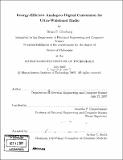Energy-efficient analog-to-digital conversion for ultra-wideband radio
Author(s)
Ginsburg, Brian P. (Brian Paul), 1980-
DownloadFull printable version (17.19Mb)
Other Contributors
Massachusetts Institute of Technology. Dept. of Electrical Engineering and Computer Science.
Advisor
Anantha P. Chandrakasan.
Terms of use
Metadata
Show full item recordAbstract
In energy constrained signal processing and communication systems, a focus on the analog or digital circuits in isolation cannot achieve the minimum power consumption. Furthermore, in advanced technologies with significant variation, yield is traditionally achieved only through conservative design and a sacrifice of energy efficiency. In this thesis, these limitations are addressed with both a comprehensive mixed-signal design methodology and new circuits and architectures, as presented in the context of an analog-to-digital converter (ADC) for ultra-wideband (UWB) radio. UWB is an emerging technology capable of high-data-rate wireless communication and precise locationing, and it requires high-speed (>500MS/s), low-resolution ADCs. The successive approximation register (SAR) topology exhibits significantly reduced complexity compared to the traditional flash architecture. Three time-interleaved SAR ADCs have been implemented. At the mixed-signal optimum energy point, parallelism and reduced voltage supplies provide more than 3x energy savings. Custom control logic, a new capacitive DAC, and a hierarchical sampling network enable the high-speed operation. Finally, only a small amount of redundancy, with negligible power penalty, dramatically improves the yield of the highly parallel ADC in deep sub-micron CMOS.
Description
Thesis (Ph. D.)--Massachusetts Institute of Technology, Dept. of Electrical Engineering and Computer Science, 2007. Includes bibliographical references (p. 207-222).
Date issued
2007Department
Massachusetts Institute of Technology. Department of Electrical Engineering and Computer SciencePublisher
Massachusetts Institute of Technology
Keywords
Electrical Engineering and Computer Science.